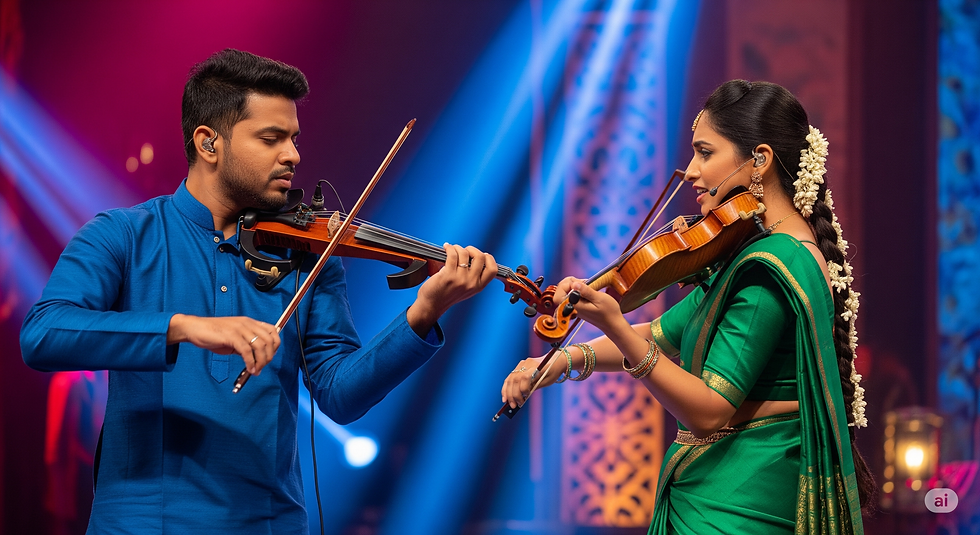"Bow, Finger, Swara: The Art of Practicing Sarali Varisai on the Carnatic Violin"
- Sharanya naidu
- Jul 28
- 3 min read
Updated: Aug 22
For anyone embarking on the beautiful journey of learning Carnatic music on the violin, the first and most crucial stepping stone is undoubtedly the Sarali Varisai. These fundamental exercises, often translated as "straightforward rows," are the bedrock upon which all future musical understanding and proficiency are built. Think of them as the scales and arpeggios of Western classical music, but with a unique Carnatic flavor and pedagogical approach.
Why is Sarali Varisai So Important?
You might be eager to jump into complex kritis and dazzling swara patterns, but patiently working through the Sarali Varisai offers a wealth of benefits that will pay dividends throughout your musical life:
Pitch Perfection (Shruti Shuddham): The primary goal of Sarali Varisai is to train your ear and fingers to accurately produce each note with perfect pitch. Each exercise systematically introduces ascending and descending patterns, allowing you to internalize the precise location and sound of every swara (note) within an octave.
Fingerboard Familiarity: For violinists, the Sarali Varisai is your guide to navigating the fingerboard. You'll learn the correct finger placement for each note, developing muscle memory that is essential for fluid playing.
Bowing Control (Dhanush Pranamam): While the left hand is busy with fingering, the right hand is equally engaged in developing precise bowing techniques. Maintaining a steady, even bow stroke for each note, especially during the repetitive patterns, is key to producing a rich and sustained sound. This is where you truly start to understand the concept of a long, clear note.
Rhythmic Understanding (Laya Gnanam): Each Sarali Varisai exercise is practiced within a specific tala (rhythmic cycle), typically Adi Tala (8 beats). This introduces you to fundamental rhythmic concepts, helping you to internalize theamic pulse and division of beats, which is critical for all Carnatic music.
Cultivating Focus and Discipline: The repetitive nature of Sarali Varisai can seem daunting at first, but it instills immense discipline and focus. This concentration is invaluable not just for music, but for many aspects of life.
Building a Strong Foundation for Gamakas: Carnatic music is rich with gamakas (ornamentations), and while Sarali Varisai doesn't explicitly teach them, it builds the foundational strength and accuracy in your fingers that are necessary to execute these intricate melodic embellishments later on.

What Does Sarali Varisai Involve?
Sarali Varisai typically consists of a series of exercises, often around 10-14, that progressively introduce different combinations of notes within the chosen raga, usually Mayamalavagowla. Mayamalavagowla is a melakarta raga (parent scale) known for its symmetrical structure and is considered ideal for beginners due to its clear interval relationships.
Each exercise will involve:
Ascending and Descending Patterns: Notes are played both upwards (Sa, Ri, Ga, Ma...) and downwards (...Ni, Dha, Pa, Ma).
Varying Note Groupings: You'll encounter patterns of single notes, pairs of notes, triplets, and so on, helping to build dexterity and precision.
Consistent Pitch and Tone: The emphasis is always on producing each note clearly, in tune, and with a good tone.
Metronomic Practice: Using a metronome is highly recommended to ensure you are practicing at a consistent tempo and developing a strong sense of rhythm.
Tips for Practicing Sarali Varisai on the Violin:
Patience is Key: Don't rush through the exercises. Focus on quality over speed. Each note should sound clear and in tune.
Listen Actively: Pay close attention to the pitch of each note. Use a tanpura app or drone to help you stay in tune.
Gentle but Firm Fingering: Press down firmly enough to produce a clear sound without pressing too hard and straining your fingers.
Smooth Bowing: Aim for a consistent and even bow stroke. Practice using the full length of the bow for long notes.
Regular Practice: Short, consistent practice sessions are far more effective than long, infrequent ones. Even 15-20 minutes a day dedicated to Sarali Varisai can make a huge difference.
Seek Guidance: Learning from a qualified Carnatic violin guru is invaluable. They can correct your technique, guide your practice, and provide personalized feedback.
Record Yourself: Sometimes, listening back to your own playing can highlight areas for improvement that you might not notice in the moment.
Your Musical Journey Begins Here
The Sarali Varisai might seem like a simple beginning, but it is the strongest foundation you can build for a fulfilling journey into Carnatic violin. Embrace these exercises with dedication and sincerity, and you'll soon discover the joy of creating beautiful music with precision and confidence. Happy practicing!



Comments